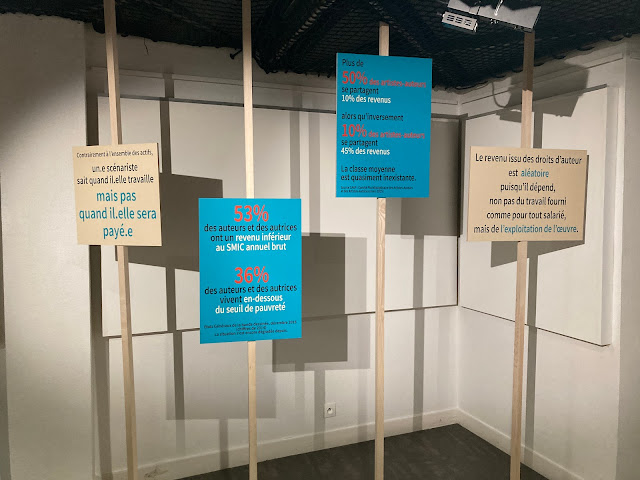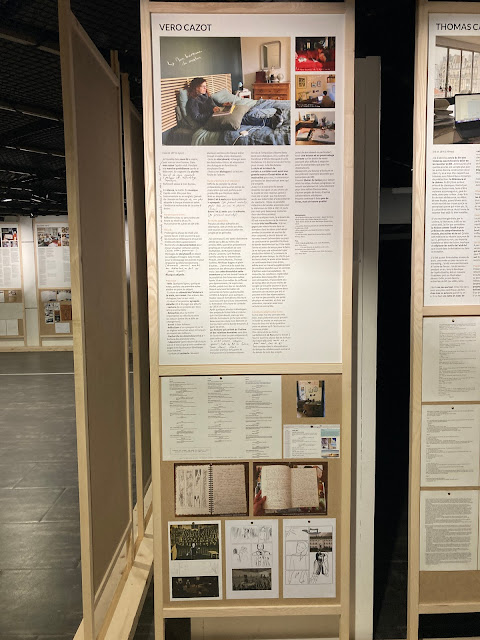Loo Hui Phang, écrire est un métier. Loo Hui Phang. Angoulème. Espace Franquin. 17-20 March 2022.
As the recipient of the 2021 Prix René Goscinny for the scenario of BLACK OUT (illustrated by Hugues Micol, published by Futuropolis in 2020), prolific Franco-Laotian author Loo Hui Phang was celebrated for the second time in five years at the Angoulême International Comics Festival with an exhibition sponsored by the Institut René Gosninny. Her first exhibition Synoptique back in 2017 offered a career overview of her work as a writer, not only for comics but for stage and screen too. In 2022, the same exhibition space in the Espace Franquin was given to Loo Hui Phang, who rightfully recognized that it was much too soon for another retrospective of her work. Instead she conceived an atypical exhibition to mount - in naming it "Writing is a Profession", Loo Hui Phang chose to pay tribute to the legacy of René Goscinny and the spirit of the prize that bears his name. Rather than keeping the spotlight on herself or focusing on the traditional display of original artwork, she structured her exhibition into three distinct sections that each addressed her relationship with the act and profession of writing itself, particularly in the milieu of comics and bande dessinée.
The first section is on immediate display outside of the entrance, serving as the exhibition's installation centerpiece. Visitors are offered a glimpse into Loo Hui Phang's personal/professional writing environment through an exact physical replica of her desk placed in a room that also abstractly presents key elements that help structure her creativity (documentation, character, dramaturgy, dialogues, and inspirations). This installation can be viewed from two perspectives: the first is behind a display window at the entrance of the exhibition; the second is through a cut-out section of the wall that is located at the tail end of the second section of the exhibition. The setup suggests an implicit invitation to revisit an initial consideration of this installation following the experience of entering into and engaging with the information presented in the next section of the exhibition.
Loo Hui Phang at the replica of her desk |
The second section situates the overall parameters of the exhibition's use of the term scénariste
(scriptwriter) as attributed to René Goscinny and his efforts to raise
technical and legal attention to his profession. Noting that the work
and plight of Goscinny and his contemporaries have inspired generations
of authors who followed in their wake, Loo Hui Phang reached out to her
colleagues in an effort to present a group portrait of comics writers
across several generations and horizons. 32 comics authors responded to
her call, each of them offering a glimpse into their individual and
idiosyncratic writing processes, habits, environments and inspiration.
Their contributions, which came in the form of responses to a
questionnaire that Loo Hui Phang composed, were edited and arranged on
large vertical display panels, accompanied by a photo of the writer in
their own writing environment and select facsimiles of notes, draft
pages of scripts, sketches, thumbnails, photos, ephemera and any other
material object that served as either a source or result of inspiration.
These panels were arranged in alphabetical order of the authors,
adjacently covering the entirety of the walls of the second section.
Loo Hui Phang (centre) discussing her exhibition with visitors |
Below
are 12 of the questions that were asked of the authors. They
were not obliged to write answers for every single question.
1. Which authors inspired you to write for comics?
2. Describe your writing career trajectory.
3. Where do you work?
4. When do you work?
5. What rituals or habits help you enter into writing?
6. What is your sonic environment when you write?
7. What is your writing process?
8. How long does it take you to write a scenario?
9. Can/do you work on multiple projects simultaneously?
10. Do you have other work outside of writing?
11. How much does comics writing factor in your revenues?
12. What are your ideal sites and conditions for writing?
A sound shower played an edited soundtrack of archival recordings of comics writers speaking about their craft. |
The final section of the exhibition draws attention to the labour plight of the contemporary comics writer in France, a struggle for recognition and legitimation that Goscinny fought during his career. A crescendoing collection of sobering facts and statistical data about the working and wage conditions of comics writers is presented on colored panels arranged at eye-level along the rest of the walls. This installation strives to inform, provoke thought, and hopes to incite action for the importance of the contribution and the compensation for comics writers, ending with a imploring declaration to defend this unique and necessary profession.
There is no question about the level of thought and consideration put in by Loo Hui Phang and everyone participating in this exhibition. The main regret of this exhibition is that all of this information, especially the individual author responses to the questionnaire, can only be read at the exhibition space itself on the panels rather than a booklet that collects their entirety, to be read at one's own time and leisure to fully absorb everything that the exhibition wishes to transmitted. While the original installation of this exhibition only lasted the duration of the Festival, its shelf life (alongside that of the René Goscinny exhibition) has been extended for another showing in France, this time at the Château de Malbrouck from 9 April to 13 November 2022. This extension ought to give visitors more time to contemplate the wealth of information that is provided and to confront the brute reality behind the trade.
-Nick Nguyen
Below are photos of all of the author panels in this exhibition, presented in the order of their installation. Click on each photo and zoom in to get a read the panel text (in French only).

























































